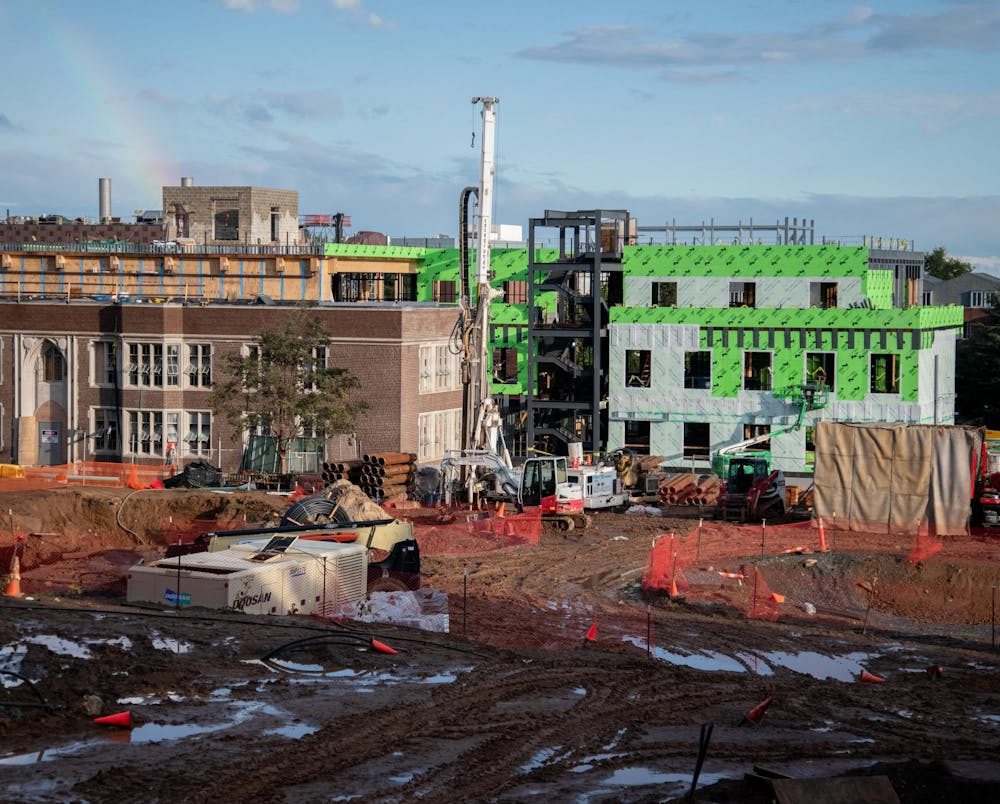Behind the ivy-covered walls of Princeton’s Nassau Hall, the sounds of construction pierce through the normal hum and drum of everyday student life. Just a few feet away, the new art museum is being built, intended to open in spring 2025. The museum is part of Princeton’s 2026 institutional plan, a campus-wide expansion that aims to improve University infrastructure and increase the student body by 10 percent. Yet, amid mounting restricted areas and swaths of caution tape, Princeton’s quest for rapid growth is becoming a crisis: Construction is widening the existing chasm between student life at the bottom and top of campus.
Blocking off the major thoroughfares that connect the southern colleges to the heart of campus is a threat to the integrity of community living. Already geographically isolated, down-campus students are forced to navigate an ever-changing set of diverted pathways due to the construction of Hobson College.
This is more than a daily inconvenience. Historically, the up-campus/down-campus divide was somewhat psychological. It is a little over half a mile from Nassau Street to Forbes, which, until recently, was the University’s southernmost college. It was simply the Princeton bubble that magnified this distance. However, as barricades are put up, the psychological is becoming physical. Along with inefficient routes and longer walk times, the campus’ sheer size post-expansion is resulting in an increasingly disjointed community. The larger campus becomes, the more disconnected down-campus students are from their up-campus counterparts.
Division culminated with the recent closure of Poe Field, a major down-campus meeting point during the warmer summer months. Bordering Yeh and New College West (NCW), Poe’s proximity to the new Coffee Club location and one of the most popular dining halls has made it a coveted spot for all Princeton students. Additionally, the field was used by clubs such as ultimate frisbee, all bringing footfall down-campus. Now under construction to install a new geo-exchange heating and cooling network, isolated down-campus students will have to wait until 2024 to feel reintegrated back into campus.
But the isolation goes further than construction separating down-campus from up-campus — the design of the new colleges also isolates students. After the new colleges won the prestigious American Institute of Architects Award, University architect Ron McCoy described the site as a “small village, full of variety and richness of experience.” Despite the dance and ceramics studios adding vibrancy to the down-campus area, alienation is still the defining feature of life as a Yeh or NCW student. Both colleges are equal in size to Butler and Whitman, housing approximately 500 undergraduate students. The new colleges feel more like a big, separated city, rather than a series of small, independent dorm communities, like most other residential colleges, where rooms are generally grouped into stairwells with separate entrances.
Kira Newbert ’26, a sophomore in NCW, said that the “new colleges’ impersonality comes from their lack of history.” As a first-year in Yeh, I shared Kira’s sentiment: When I joined Princeton, I felt lost in a brand new community that lacked a definitive identity. Without a proper mascot around which to build character Yeh, consisting of mainly first-year students, felt isolating and fostered a wholly different student experience to that of my friends in Mathey and Rocky. From the get-go, it was more difficult to make meaningful connections and assimilate into McCoy’s vision.
As Preston Ferraiuolo ’26 noted in a recent column for the ‘Prince,’ greater investment in TigerTransit would improve mobility between the bottom and top of campus. While this would provide a short-term solution for alienated students, a reduction in the rapidity of construction is urgently needed. Princeton’s strategy should not simply be a matter of growth at all costs, but rather one that focuses on community building and student integration.
If the University wants to foster community inside the new colleges and between down-campus and up-campus areas, they need to meet with students and create a construction mitigation plan. This could include pausing work on existing projects such as the rebuilding of the University Health Center and instead redirecting resources towards the completion of Hobson and adjacent buildings. Given its extensive disruption, mid-campus construction should be of particular focus. The University should temporarily halt work in and around Butler as well as Frist Campus Center, only restarting when students are off-campus for break. Reopening paths in these areas is crucial, as they provide the most direct route from the new colleges to Mathey, Rocky, and beyond.

Both the completed construction projects and those in progress fail to promote campus connection. Princeton’s construction conundrum is a hindrance to a cohesive university experience. Pausing current projects would particularly benefit new college students. By decreasing the mental and physical barriers of separation between down-campus and up-campus, those in Yeh and NCW especially would feel less affected by the buildings’ isolating architecture and lack of identity.
Chloe Cresswell is a sophomore from London, UK, intending to major in the School of Public and International Affairs. She is a contributing columnist for the ‘Prince’ and can be reached by email at cc8553@princeton.edu.









